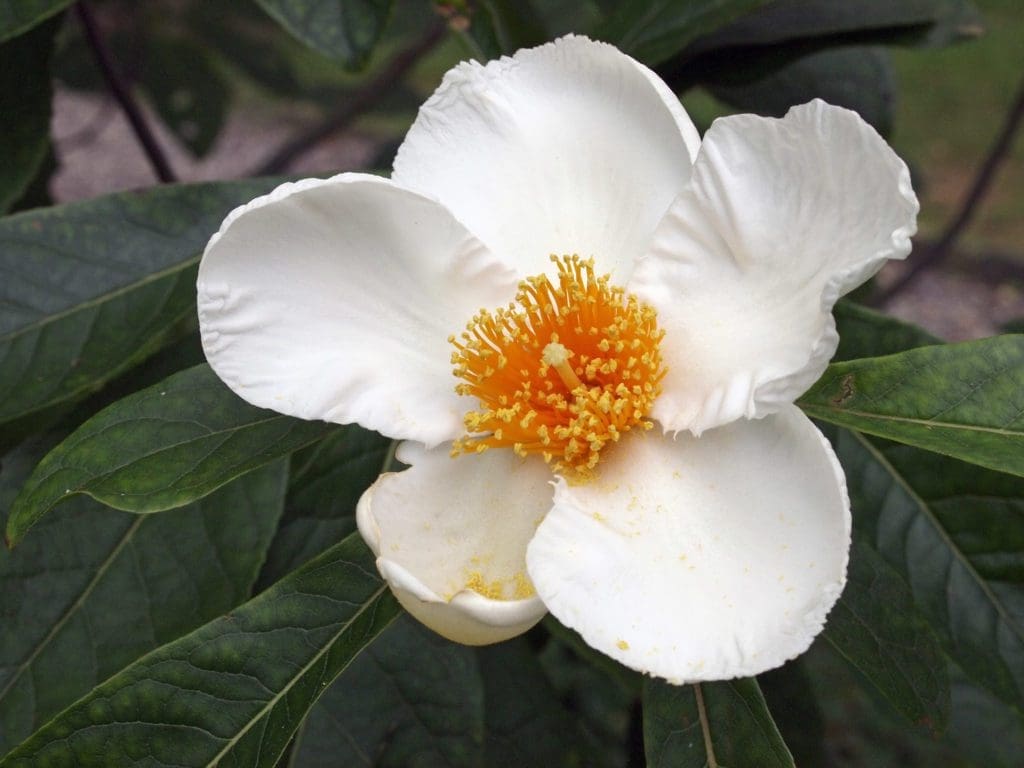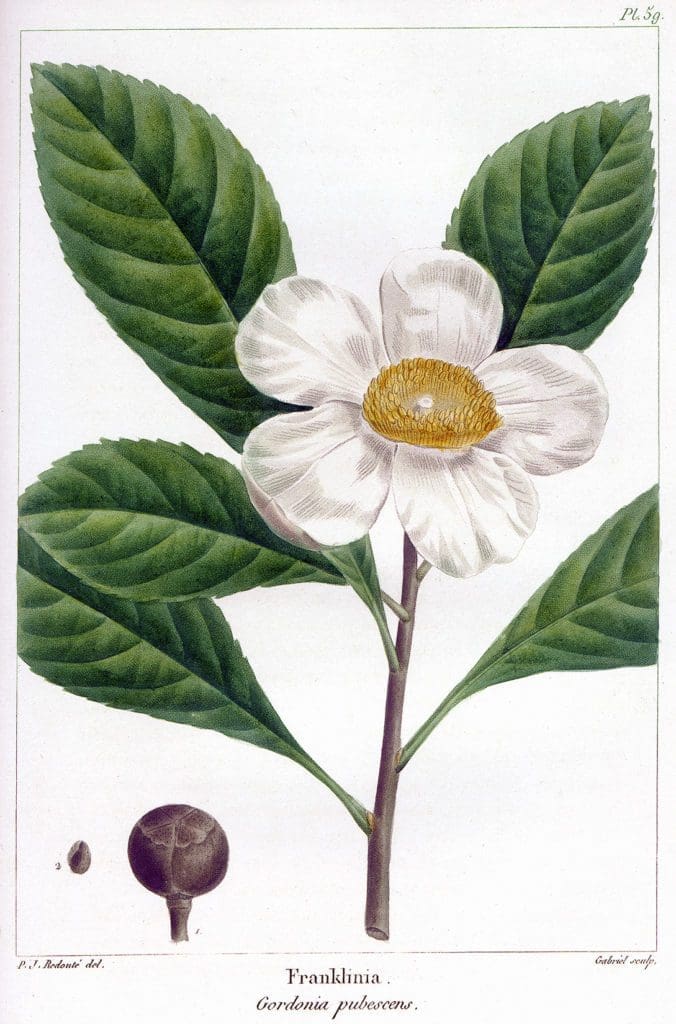Franklinia Series: Finding Franklinia alatamaha (Part One)

Our Franklinia alatamaha is starting to bloom! Over the next several weeks, curator Joel Fry will explain the history behind Franklinia and the Bartrams in a three-part series!
Passages taken from “Franklinia alatamaha, A History of That “Very Curious” Shrub” by Joel T. Fry, in Bartram Broadside, Special Franklinia Edition, published by the John Bartram Association for the ‘noble & curious friends’ of Historic Bartram’s Garden (Winter 2000).
John and William Bartram encountered that “rare and elegant flowering shrub,” Franklinia alatamaha, October 1, 1765, after losing their way to the crossing of the Altamaha River at Fort Barrington in southeast Georgia. Since that event, this rare plant has continued to fascinate gardeners and botanist alike, around the globe. Much has been written about this plant—often ill informed, or incorrect. The celebrity and the scientific credibility of John and more importantly William Bartram have been intrinsically tied to the fate of Franklinia. An academic dispute over the genus and official name of the shrub has simmered between botanists in the United States and Europe for over two centuries and has yet to be settled. Franklinia is still known as Gordonia pubescens in many European texts.
Franklinia alatamaha is apparently extinct in the wild. Prior to 1900 Franklinia was extremely rare in gardens, and could easily have been lost to the world altogether. Surprisingly, there is little record of significant effort to ensure its survival after 1850, when the last Bartram heirs were forced to sell the family botanic garden. The current resurgence of Franklinia is largely due to luck and the natural tenacity of the plant itself. Now in the early 21st century, Franklinia is flourishing in cultivation. It remains that curious plant saved from extinction, beautiful, floriferous, and just difficult and rare enough in cultivation to make it a prize to grow.
Franklinia is a beautiful flowering shrub or small tree, long-lived and hardy well into the north. As a deciduous plant, the leaves of Franklinia color a bright red to maroon in the late fall before dropping, adding to the show. The flowers are numerous, and although each lasts only a day, at the peak of flowering the plant is covered day after day with blooms, often continuing for months until frost. The flowers are scented “with the fragrance of the China Orange.”[1] As a member of the Tea family or Theaceae, it bears a strong family resemblances in both leaves and flowers to those prized Asian exotics the Tea and the Camellia, as well as to the native Gordonia and Stewartia. Franklinia is a hardy shrub with large flowers like single camellias and an orange-blossom scent—this in many ways describes a perfect plant for the 18th century Anglo-American garden. If the actual plant did not survive, one could almost imagine it had been concocted to suit the fancies of John and William Bartram.
“The useful, the beautiful, the singular or the fragrant are to us the most material,” wrote Dr. John Fothergill from London in 1772 in a series of instructions for William Bartram prior to his explorations in the American South.[2] Franklinia fulfills at least three of these criteria: it is singular, beautiful and fragrant. Singularity was perhaps the most valued feature to the collectors of the 18th and 19th century. To be the first to possess a rare plant created aesthetic, scientific, and monetary wealth. The Bartrams and their clients were prepared to wait years, even decades to see a prized flower raised from seed. Acquiring rare plants was an expensive diversion for wealthy amateurs and the titled nobility. Daniel Solander writing Linnaeus in October 1760 remarked of British nurserymen, “When buying is in question they never talk of less than half a Guinea and 1 Guinea, or often 2 or 3 Guineas and more for a young bush…”[3] Even relatively common North American plants could become valuable collectables in Europe for a time, but the singular Franklinia has remained a rare and difficult subject to this day.

John and William Bartram were uniquely prepared for their chance meeting with Franklinia when they encountered it October 1, 1765. John’s skill as a “natural botanist” and his lifetime of observation in the wild and in his garden, combined with William’s close experience with the plants of the southern coastal plain had left them particularly equipped. John Bartram recorded in his journal:
… we mised our way & fell 4 mile below fort barrington where we lodged this night this day we found severall very curious shrubs one bearing beautiful good fruite.[4]
This cryptic record of the original encounter with Franklinia confounds attempts to reconstruct the history of the plant. Was the plant in leaf? Did the Bartrams take leaf specimens, seed or seed capsules? “Curious” was an important code word to Bartram and his fellow 18th century scientists indicating rare, valuable, beautiful, and scientifically interesting. “Very curious” heightens the significance of the discovery. Based on William Bartram’s later elaborations, the “severall very curious shrubs” have been identified as Franklinia alatamaha and the Fever Tree or Pinckneya bracteata, although it is possible John Bartram was noting more than two new species. Writing Robert Barclay in November 1788, William Bartram reported that the plant now known as Pinckneya was “discovered in the maritime parts of Georgia & Et Florida, above 20 years ago, when attending my Father John Bartram on Botanical researches; but that excursion being in the Autumn, We saw only the dry Seed vessels.”[5] This suggests it was the Pinckneya that was “bearing beautiful good fruite.”
As to the Franklinia, William Bartram would later write he and his father “could form no opinion to what class or tribe it belonged.”[6]
Someone unfamiliar with the plants of the southeast would probably not have noticed Franklinia, and certainly not recognized its rarity. The following day, October 2nd, Bartram also noted:
…this uncommon season of rain which hath not been seen above 40 years has reached thro all these southern provinces by the best accounts hath destroyed much of thair rice where the waters rose commonly 5 foot deep…[7]
John Bartram’s note of extensive, heavy rain may explain why the Bartrams were unable to provide a better description of Franklinia at their first encounter. Although exceptionally long-flowered, often continuing until frost, Franklinia will stop flowering in the face of heavy rains, and the shed flowers readily dissolve into an unrecognizable slime. Out of bloom, Franklinia might not be distinguished from the more pervasive Loblolly Bay unless its leaves were changing to their fall red tone. It could have been this color that attracted the eyes of John and William Bartram. The seeds are generally shed from the shrub in the late fall in Pennsylvania, but it is possible and even likely seed dispersal was earlier in Georgia. Even so, the open woody seed capsules should have remained.
The first of several mysteries about the Franklinia remains: did John and William Bartram take specimens of the plant when they first encountered it in October 1765? Specimens or even seeds could have been collected and sent to England with the King’s boxes in 1765- 1766, or to Peter Collinson with a copy of John Bartram’s journal of the entire southern trip in December 1766.[8]
The whereabouts of both the King’s specimens and Collinson’s copies of Bartram’s journals are unknown and presumed lost. John Bartram’s own draft catalogue of “A Box sent to the King 1766 with the following plants” lists: “N. 21 A curious shrub.”[9] This box for the King was probably prepared in Philadelphia in the fall of 1766, after Bartram’s return from the South. While it seems unlikely this shrub was Franklinia, at present there is no way to determine which “curious shrub” Bartram sent. There is not another word about Franklinia from the hand of John Bartram.
Read the full paper here:
“Franklinia alatamaha, A History of That “Very Curious” Shrub”
Read part two here:
Franklinia Series: Finding Franklinia alatamaha (Part Two)
Notes
[1] Humphry Marshall, Arbustrum Americanum: the American Grove or an alphabetical Catalogue of Forest Trees & Shrubs, Natives of the American United States, arranged according to the Linnaean System… (Joseph Crukshank, Philadelphia, 1785), 49.
[2] John Fothergill letter to William Bartram, October 22, 1772, William Bartram, The Search for Nature’s Design: Selected Art, Letters, and Unpublished Writings, ed. by Thomas Hallock and Nancy E. Hoffmann, (Athens, GA: University of Georgia Press, 2010), 86.
[3] Daniel Solander letter to Linnaeus, October 1760, Daniel Solander: Collected Correspondence 1753-1782, ed. and trans. by Edward Duyker and Per Tingbrand (Oslo-Copenhagen-Stockholm: Scandinavian University Press, 1995), 144.
[4] John Bartram, “Diary of a Journey through the Carolinas, Georgia, and Florida from July 1, 1765 to April 10, 1766,” ed. & annotated by Francis Harper, Transactions of the American Philosophical Society, N.S. vol. 33, part 1 (1942), 31.
[5] William Bartram letter to Robert Barclay, November 1788, William Bartram, The Search for Nature’s Design: Selected Art, Letters, and Unpublished Writings, ed by Thomas Hallock and Nancy E. Hoffmann, (Athens, GA: University of Georgia Press, 2010), 148.
[6] William Bartram, Travels… (Philadelphia: James & Johnson, 1791), 467.
[7] John Bartram, “Diary of a Journey through the Carolinas, Georgia, and Florida…,” 31.
[8] John Bartram’s specimens for the King and his journal from the trip to Florida are mentioned in several letters to Collinson. The Correspondence of John Bartram, 1734-1777, eds. Edmund Berkeley and Dorothy Smith Berkeley (Gainesville: University Presses of Florida, 1992), 668-669, 673674, 679, 684, 688-689, 709, 726.
[9] John Bartram, “A Box sent to the King 1766 with the following plants,” Historical Society of Pennsylvania, Bartram Papers 4:69. [On rear of letter of John Lane to John Bartram, London, April 7, 1766].


